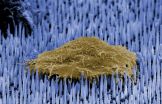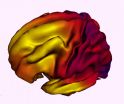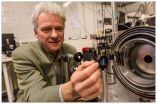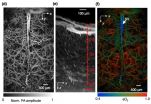The researchers, from Imperial College London and Houston Methodist Research Institute in the USA, hope their nanoneedle technique could ultimately help damaged organs and nerves to repair themselves and help transplanted organs to thrive.
The nanoneedles work by delivering nucleic acids to a specific area. Nucleic acids are the building blocks of all living organisms and they encode, transmit and express genetic information. Scientists are currently investigating ways of using nucleic acids to re-program cells to carry out different functions.
The nanoneedles are tiny porous structures that act as a sponge to load significantly more nucleic acids than solid structures. This makes them more effective at delivering their payload. They can penetrate the cell, bypassing its outer membrane, to deliver nucleic acids without harming or killing the cell. The nanoneedles are made from biodegradable silicon, meaning that they can be left in the body without leaving a toxic residue behind. The silicon degrades in about two days, leaving behind only a negligible amount of a harmless substance called orthosilicic acid.
In a trial described in Nature Materials, the team showed they could deliver the nucleic acids DNA and siRNA into human cells in the lab, using the nanoneedles. They also showed they could deliver nucleic acids into the back muscles in mice. After seven days there was a six-fold increase in the formation of new blood vessels in the mouse back muscles, and blood vessels continued to form over a 14 day period. The technique did not cause inflammation or other harmful side effects.
The hope is that one day scientists will be able to help promote the generation of new blood vessels in people, using nanoneedles, to provide transplanted organs or future artificial organ implants with the necessary connections to the rest of the body, so that they can function properly with a minimal chance of being rejected.
"This is a quantum leap compared to existing technologies for the delivery of genetic material to cells and tissues," said Ennio Tasciotti, Co-Chair, Department of Nanomedicine at Houston Methodist Research Institute and co-corresponding author of the paper. "By gaining direct access to the cytoplasm of the cell we have achieved genetic reprogramming at an incredible high efficiency. This will let us personalize treatments for each patient, giving us endless possibilities in sensing, diagnosis and therapy. And all of this thanks to tiny structures that are up to 1,000 times smaller than a human hair."
Professor Molly Stevens, co-corresponding author from the Departments of Materials and of Bioengineering at Imperial College London, said: "It is still very early days in our research, but we are pleased that the nanoneedles have been successful in this trial in mice. There are a number of hurdles to overcome and we haven't yet trialled the nanoneedles in humans, but we think they have enormous potential for helping the body to repair itself."
The researchers are now aiming to develop a material like a flexible bandage that can incorporate the nanoneedles. The idea is that this would be applied to different parts of the body, internally or externally, to deliver the nucleic acids necessary to repair and reset the cell programming.
Dr Ciro Chiappini, first author of the study from the Department of Materials, added: "If we can harness the power of nucleic acids and prompt them to carry out specific tasks, it will give us a way to regenerate lost function. Perhaps in the future it may be possible for doctors to apply flexible bandages to severely burnt skin to reprogram the cells to heal that injury with functional tissue instead of forming a scar. Alternatively, we may see surgeons first applying the nanoneedle bandages inside the affected region to promote the healthy integration of these new organs and implants in the body. We are a long way off, but our initial trials seem very promising."
INFORMATION:
For further information please contact:
Colin Smith
Senior Research Media Officer
Communications and Public Affairs
Imperial College London
South Kensington Campus
London SW7 2AZ
Tel: +44 (0)20 7594 6712
Email: cd.smith@imperial.ac.uk
Duty press officer mobile: +44 (0)7803 886248
Notes to editors:
"Biodegradable silicon nanoneedles delivering nucleic acids intracellularly induce localized in vivo neovascularization", published March 30 2015, in Nature Materials journal.
C. Chiappini [1],[2], E. De Rosa [3], J. O. Martinez [3], X. Liu3, J. Steele [1],[2], M. M. Stevens [1], [2] and E. Tasciotti [3] [1] Department of Materials, Imperial College London, London, SW6 7PB, UK.
[2] Department of Nanomedicine, Houston Methodist Research Institute, Houston, Texas 77030, USA.
[3] Department of Bioengineering and Institute of Biomedical Engineering, Imperial College London, London, SW6 7PB, UK.
2. About Imperial College London
Consistently rated amongst the world's best universities, Imperial College London is a science-based institution with a reputation for excellence in teaching and research that attracts 14,000 students and 6,000 staff of the highest international quality. Innovative research at the College explores the interface between science, medicine, engineering and business, delivering practical solutions that improve quality of life and the environment - underpinned by a dynamic enterprise culture.
Since its foundation in 1907, Imperial's contributions to society have included the discovery of penicillin, the development of holography and the foundations of fibre optics. This commitment to the application of research for the benefit of all continues today, with current focuses including interdisciplinary collaborations to improve global health, tackle climate change, develop sustainable sources of energy and address security challenges.
http://www.imperial.ac.uk
3. About Houston Methodist Research Institute
Houston Methodist Hospital, the system's flagship, is listed among U.S. News & World Report's best hospitals and is ranked as the best hospital in Texas. FORTUNE magazine has placed Houston Methodist on its annual list of "100 Best Companies To Work For" since 2006. It is the only health care organization in Texas on the list.
Houston Methodist Research Institute was formed in 2004 to rapidly and efficiently translate discoveries made in the laboratory and the clinic into new diagnostics, therapies and treatments. Important advances in biomedical sciences and health care are made by collaborative, interdisciplinary teams of individuals with diverse scientific backgrounds and training. TMHRI was created to provide the infrastructure and support for these endeavours, and to house the technology and resources needed to make innovative breakthroughs in important areas of human disease. A new 440,000-square-foot facility, was opened in 2010 to house scientists engaged in cutting edge research in Nanomedicine, Cardiovascular sciences, Cancer, Neurosciences, Regenerative Medicine, Infectious disease, and more.
http://www.hmleadingmedicine.com






